

Introduction to Aeoniums. (Editor's Note: This article was originally published on May 12, 2008.
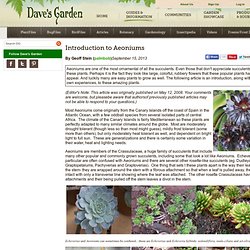
Your comments are welcome, but pleasebe aware that authorsof previously published articles may not be able to respond to your questions.) Most Aeoniums come originally from the Canary Islands off the coast of Spain in the Atlantic Ocean, with a few oddball species from several isolated parts of central Africa. The climate of the Canary Islands is fairly Mediterranean so these plants are perfectly adapted to many similar climates around the globe. Most are moderately drought tolerant (though less so than most might guess), mildly frost tolerant (some more than others), but only moderately heat tolerant as well, and dependent on bright light to full sun.
These are generalizations and there is certainly some variation in their water, heat and lighting needs. Echeverias and Aeoniums can sometimes be confused... these are Echeverias and Echeveria hybrids: sedundiflora, nuda-ciliata and set-oliver Aeonium canariense in So. Detailed information on Gasteria Gasteria carinata var. verrucosa. Euphorbia platyclada: A living plant that looks dead. I probably should have waited to post this until it was doing something more exciting than simply being alive in a pot, but the fact that it is alive at all is one reason why I find this euphorbia so thrilling in the first place.

Euphorbia platyclada is a living succulent plant that looks dead, or at the very least like a zombified plant taking imperceptible micro-steps forward with its leafless arms* splayed out and fingers dangling like dead weights. It is yet another oddity in my growing collection of alien euphorbias from outer space, and was also a gift from my friend and fellow Euphorbia enthusiast Uli. [Aside: Davin says that this description and post title is the product of having played too much Plants Versus Zombies. Peyote. Lophophora williamsii /loʊˈfɒfərə wɪlˈjæmsiaɪ/ is a small, spineless cactus with psychoactive alkaloids, particularly mescaline.[2] The Spanish common name, also used in English, is peyote[3] (/pəˈjoʊti/; from the Nahuatl word peyōtl [ˈpejoːt͡ɬ]), which means "glisten" or "glistening".[4] [5] Native North Americans are likely to have used peyote, often for spiritual purposes for at least 5,500 years.[6] Peyote is native to southwestern Texas and Mexico.
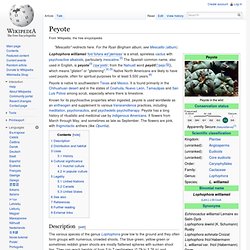
It is found primarily in the Chihuahuan desert and in the states of Coahuila, Nuevo León, Tamaulipas and San Luis Potosi among scrub, especially where there is limestone. Description[edit] Lophophora williamsii with small, red fruit The various species of the genus Lophophora grow low to the ground and they often form groups with numerous, crowded shoots. Lophophora williamsii seedling at roughly 1 1/2 months of age The cactus produces flowers sporadically; these are followed by small edible pink fruit. Lophophora williamsii (peyote) Dr. Euphorbia milii. Description[edit] Stamens and carpels It is a succulent climbing shrub growing to 1.8 m (5 ft 11 in) tall, with densely spiny stems.
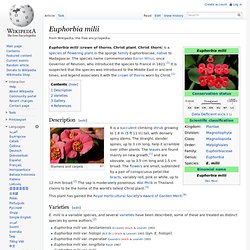
The straight, slender spines, up to 3 cm long, help it scramble over other plants. The leaves are found mainly on new growth,[1] and are obovate, up to 3.5 cm long and 1.5 cm broad. The flowers are small, subtended by a pair of conspicuous petal-like bracts, variably red, pink or white, up to 12 mm broad.[2] The sap is moderately poisonous. This plant has gained the Royal Horticultural Society's Award of Garden Merit.[4] Varieties[edit] Euphorbia milii var. bevilaniensis (Croizat) Ursch & Leandri 1955Euphorbia milii var. hislopii (N.E.Br.) Ariocarpus_kotschoubeyanus_San_Francisco.jpg (JPEG Image, 700 × 559 pixels) Agave—How to Grow Agave Indoors. Agave can be exceptional houseplants, depending on which one you buy.
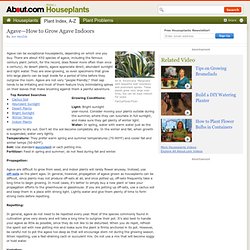
There are about 450 species of agave, including the famous century plant (which, for the record, does flower more often than once a century). As desert plants, agave appreciate direct, abundant sunlight and light water. They are slow-growing, so even specimens that grow into large plants can be kept inside for a period of time before they outgrow the room. Agave are not very "people friendly;" their sap tends to be irritating and most of them feature truly intimidating spines on their leaves that make brushing against them a painful adventure.
Growing Conditions: Light: Bright sunlight year-round. Propagation: Agave are difficult to grow from seed, and indoor plants will rarely flower anyway. Repotting: In general, agave do not need to be repotted every year. Varieties: There are dozens of species of agave found in cultivation, including many species that grow into giants. A. americana. Castor oil plant. Its seed is the castor bean, which, despite its name, is not a true bean.
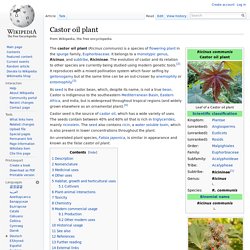
Castor is indigenous to the southeastern Mediterranean Basin, Eastern Africa, and India, but is widespread throughout tropical regions (and widely grown elsewhere as an ornamental plant).[4] Castor seed is the source of castor oil, which has a wide variety of uses. The seeds contain between 40% and 60% oil that is rich in triglycerides, mainly ricinolein.